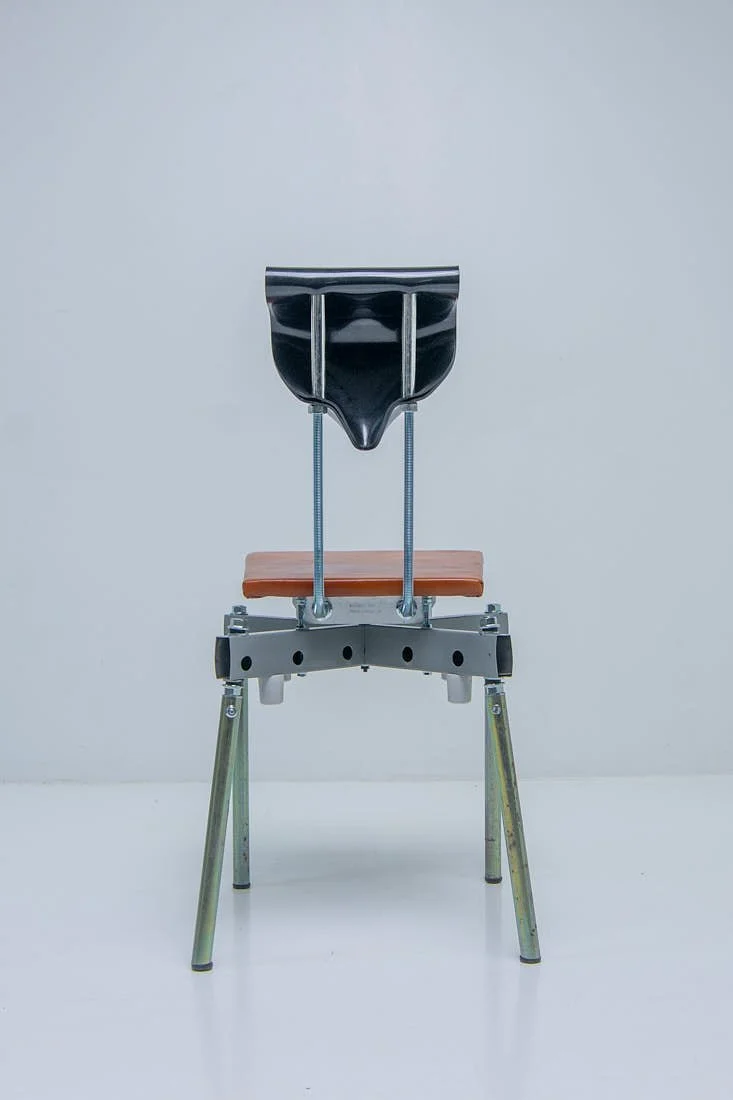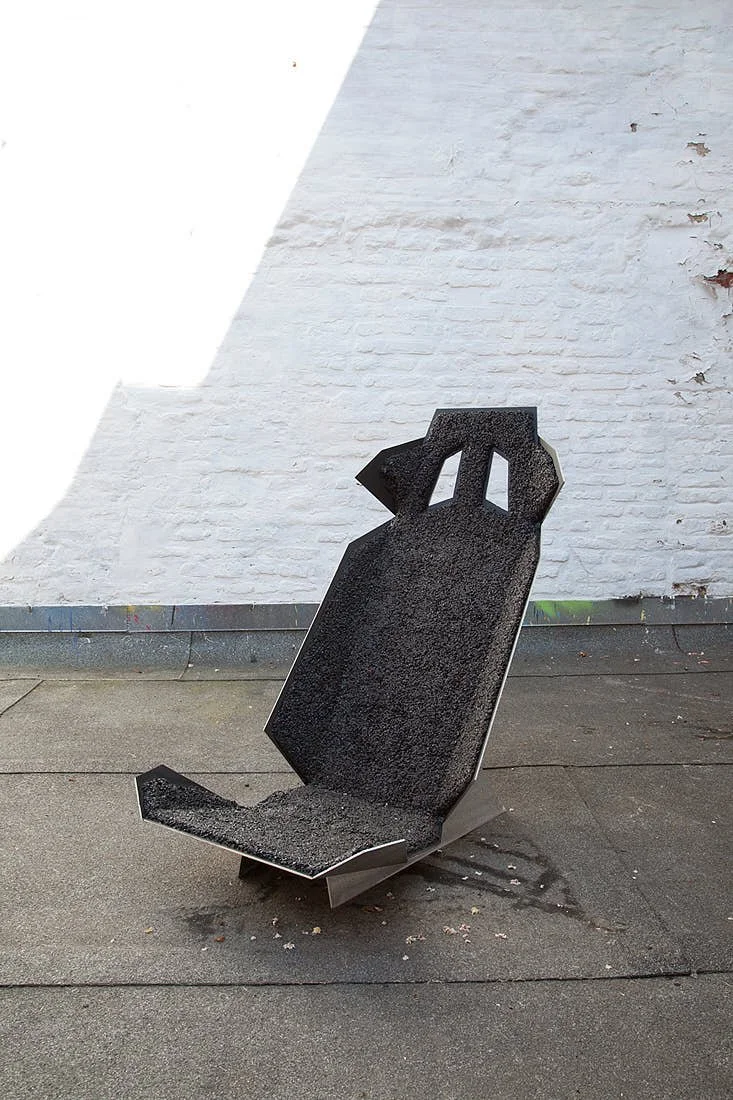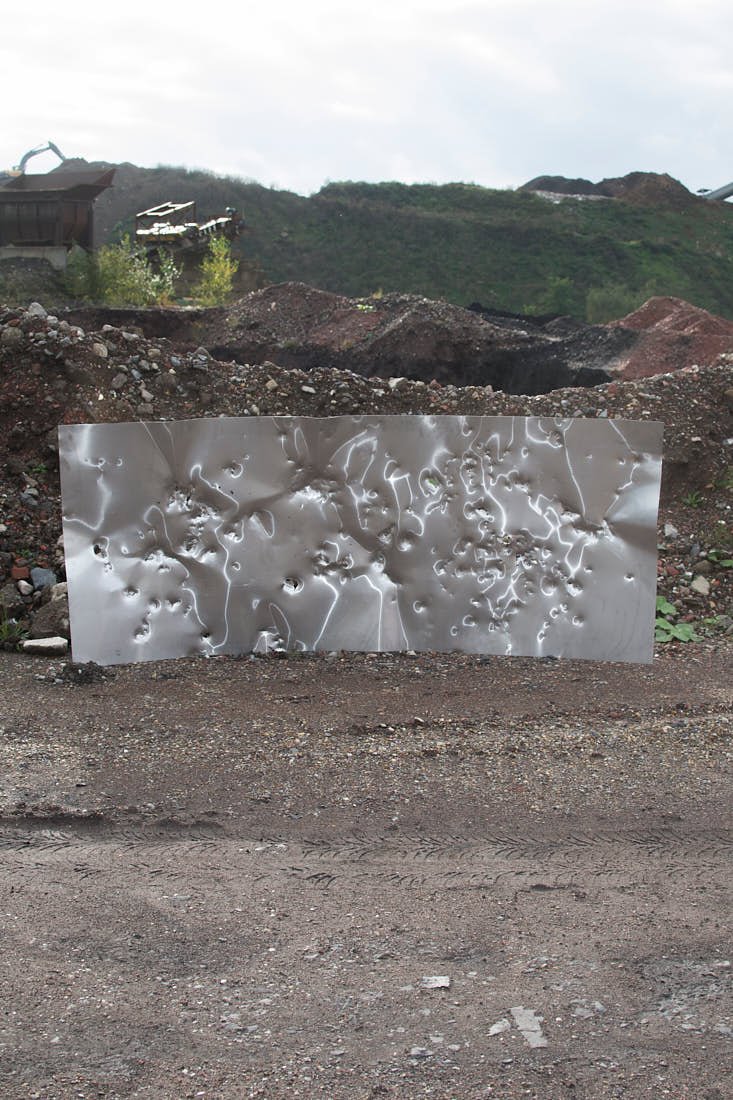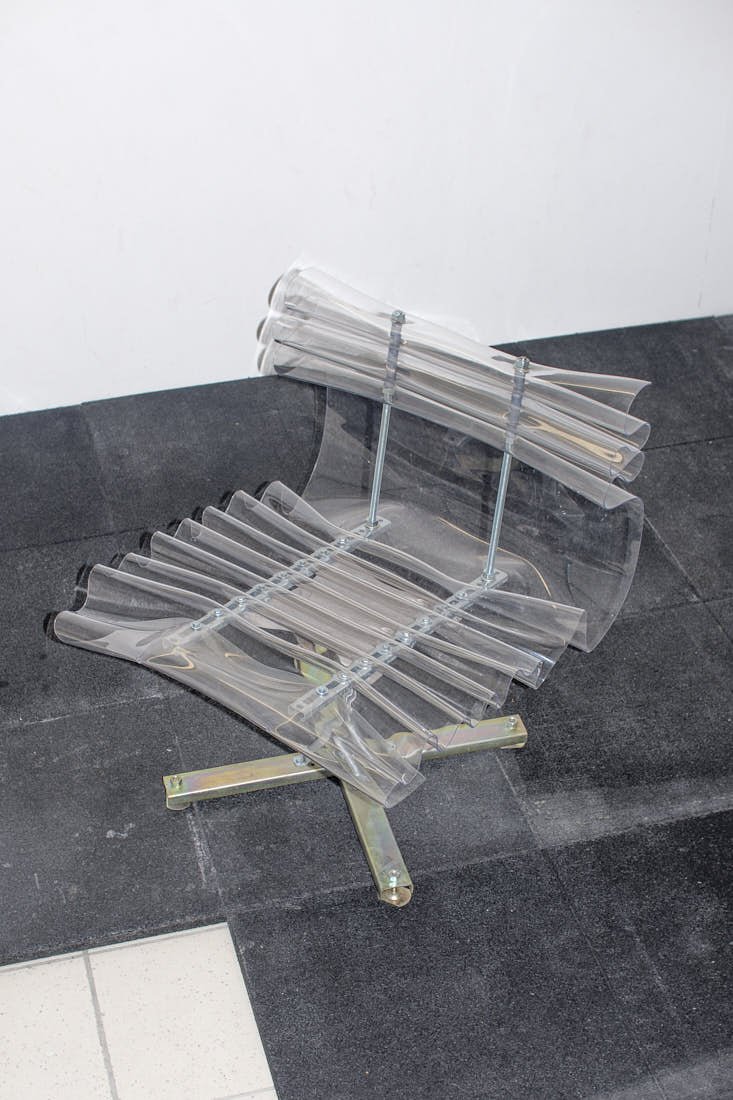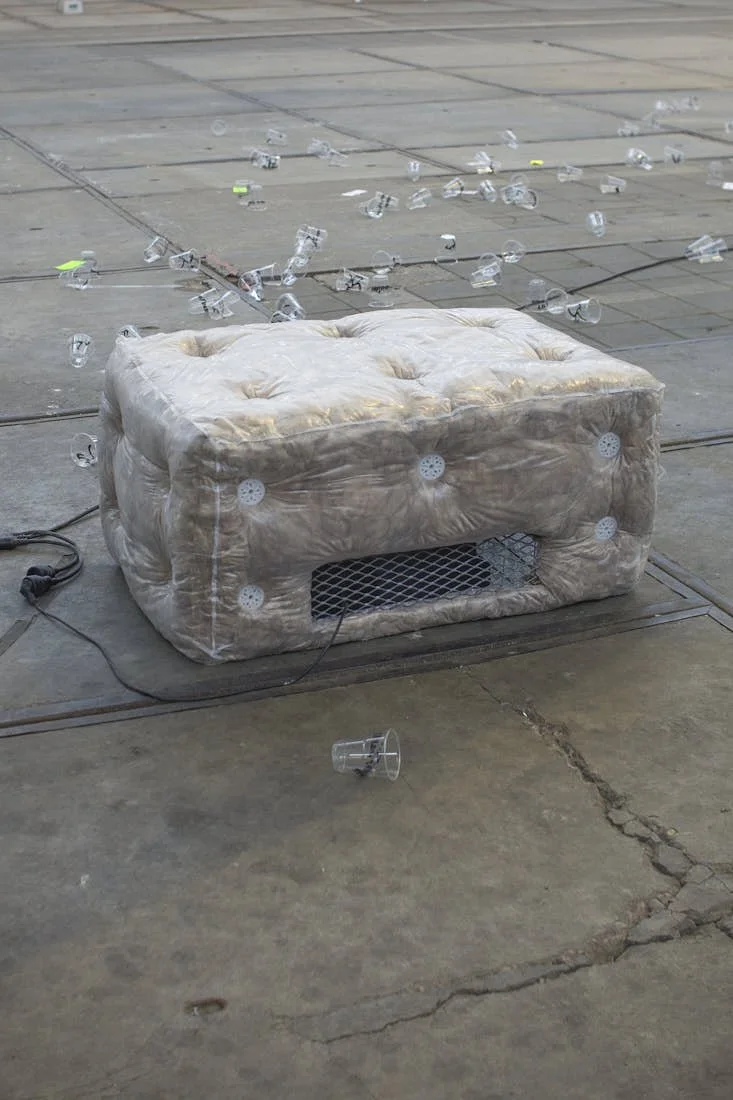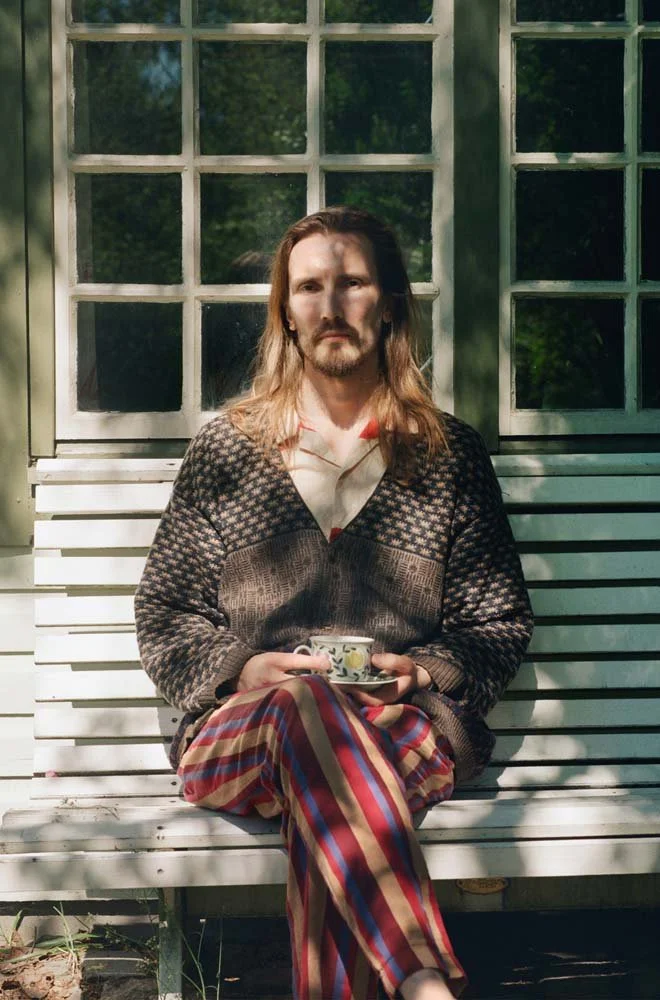ARNAUD EUBELEN
*Material Is Offline, Everything Else Just Scrolls Past
interview + written MELANIA MUSCI
Arnaud Eubelen’s design unfolds intriguingly at the crossroads of art and industrial design. Trained between Liège and Brussels, he has cultivated a strong interest in discarded materials, a fascination that has become one of his defining traits.
His creations are deeply informed by their surrounding environment, reflecting society’s evolution through the very materials it chooses to abandon. By giving new life to what is often overlooked, his practice opens a dialogue about consumption, transformation, and the narratives embedded within everyday matter.
Arnaud’s pieces are unique yet reproducible. Every assembly system and proportion is engineered for duplication, ensuring his work can be reconstructed without compromising its conceptual integrity. What changes, however, is the material itself—an element at the very core of his practice—shaped by the resources available in what Arnaud calls his personal hardware store: the city itself. This approach keeps each work flexible and adaptive, anchored in a specific time and place, and deeply rooted in sensory experience.
Diplomatic Corps / design by Arnaud Eubelen
“For me, the most rewarding aspect is knowing that an object will find not a definitive home, but a context where it can exist, be used, and activated.”
Arnaud Eubelen speaks with Melania Musci
for LE MILE OFFLINE Edition Nr. 39 FW25/26
Many of his pieces are designed to invite direct interaction: objects that must be touched, activated, and transformed, shifting in shape or proportions, and encouraging audiences to rediscover a tactile dimension that is gradually disappearing from everyday life. In this sense, being offline is part of the artist’s approach and an experience shared with those who engage with his work, where touch and physical presence are essential to its meaning. Arnaud reflects on the influences that shaped him during his academic years and on how he has found a balance between analog and digital processes in his creative practice.
He addresses timely issues such as social media’s impact on the creative scene and the gentrification of cities—forces that affect today’s available materials and will shape their future use.
Rooted in research, his work increasingly looks beyond urban environments toward rural spaces free from constraints, enabling continued experimentation and new ways of embracing an offline, tangible reality.
He Drank Us, 2019 Detail / design by Arnaud Eubelen
He Drank Us, 2019 Detail / design by Arnaud Eubelen
Melania Musci
Your fascination with discarded materials began during your teenage years, but initially manifested through graffiti art and photography. What pushed you to experiment hands-on with these materials?
Arnaud Eubelen
I think the first key influence was my industrial design studies. At the academy, the focus was heavily on how objects are made, their composition, and the strengths and weaknesses of different resources. At that time, I didn’t have the financial means to work with expensive components, so it felt natural to turn to what was freely available around me.
During this period, I also co-founded a collective with friends. We focused on creating decorations for clubs, organizing events where most of the decor was built from items we salvaged from the streets. That experience deeply shaped my artistic approach, merging a kind of scenographic sensibility with a fascination for the objects we discovered.
Soon after, I joined an artist residency in Toulouse, France, where the entire project revolved around creating a piece from objects found on the street. That experience made me start collecting discarded items more consciously and realize that I was far more drawn to them than to new ones.
This completely challenged the principles of my academic training, which had taught me to strive for objects that seemed entirely new. Through these insights, I was able to develop my own distinct perspective and let go of the frustration that came with chasing an unattainable ideal of perfection.
In a previous interview, you reflected on how traditional design studies can often shape and standardize the vision of emerging artists, potentially leading to a certain uniformity in their work. Given this perspective, if you could go back, would you still choose the same academic path?
I don’t believe this applies universally to every school. There are many design and industrial design programs, and increasingly, art schools are becoming highly interdisciplinary, integrating different fields. However, when I attended over a decade ago, things were quite different. Today, through my experiences as a jury member, I see many schools adopting a very open-minded approach to how we engage with objects—not only industrial ones—which promotes a broader understanding of the things we interact with daily. Despite this, I don’t regret my studies, as they were truly formative. I attended two different schools, one in Liège and one in Brussels, each with a distinct teaching philosophy. Liège focused heavily on industrial and technical aspects, with less emphasis on artistic expression. In contrast, Brussels, while still rooted in industrial design, pushed us to think conceptually and to delve into the motivations behind our desire to create. It was less about simply solving problems and more about clarifying your core intentions. For me, this dual experience was invaluable. That said, whether a program is suitable depends largely on your personal goals and on the school itself. Perhaps the first question any institution should ask is: What do you truly want to achieve?.
Would you mind telling me about the design phase of your work? When building something new, do you start with the idea of the final object, or do you experiment with materials until they take on a concrete form?
It really depends. Some pieces are created specifically for exhibitions, where I already have a clear vision of the final outcome, and the process is guided by that goal. Other works, however, arise simply from the urge to bring something into existence, without a predefined endpoint. In that sense, context plays a crucial role: where I produce the work, and for whom it is intended, often shape the process itself. The materiality of the object is also deeply connected to my surroundings, particularly the area around my workshop. I draw immense inspiration from urban spaces, public or semi-private places like bars, train stations, or other environments designed for people to gather, socialize, or wait. I’ve always had a strong interest in these in-between spaces that aren’t fully private. This environment often determines the materials I find and influences the way they evolve into new forms.
Road Trip, 2018, 70x100x50 / design by Arnaud Eubelen
photo by Ludovic Beillard
Altar Process / design by Arnaud Eubelen
The theme of this issue of Le Mile is "Offline," and that perfectly aligns with your process, which we could call totally analog. Have you ever integrated digital or virtual design processes into your work?
I typically use very simple digital tools. In school, I worked with more advanced software, but I found it too restrictive for my way of working and ultimately unnecessary. The programs I use now are minimal, focused mainly on proportions and dimensions rather than elaborate renderings. They’re ideal for integrating my work into 3D models of interior spaces. For instance, if I can’t visit an exhibition site beforehand, I’ll create a basic model of the space and place digitized versions of my objects inside it. These tools are valuable for visualizing how my work interacts with a given environment and, more importantly, for avoiding mistakes. The materials I use may not hold monetary value for others, but for me, they are unique pieces. I need to ensure I don’t waste them by making incorrect cuts or working with the wrong measurements. 3D modeling gives me precision, especially when preparing for photography or sharing my work on social media.
Staying on the topic of digital, do you think it's important for a contemporary product designer to share their work on social media? Since you're more connected to a "concrete world," do you find this challenging?
That’s a big question, and I’m not sure there’s a definitive answer, because digital platforms are profoundly reshaping our world. For example, galleries no longer hold the same authority they once did, as social media has changed how audiences engage with art and design. On one hand, there are clear advantages. An artist can work from a small, remote studio and still reach a global audience. On the other hand, social media is largely about image. I’ve noticed exhibitions sometimes designed specifically to be “social media-friendly,” and that imposes certain constraints. It’s a delicate issue because we still have eyes, hands, and bodies; we continue to live in the physical world. Experiencing objects in person should remain fundamental. Too often, we see images online without ever encountering the real object, and this can create a disconnect from reality and, in some cases, limit creative thinking. This idea of disconnection is central to my work. I try to actively counter it by engaging with reality, context, and tactility. Many of my objects are interactive. You need to touch them to activate them, changing their shape or proportions.
That said, social media has undoubtedly opened doors for me. I would estimate that half of my projects have come from people discovering my work on Instagram. As I mentioned, it’s a complex subject, one we could easily spend hours exploring.
Do you think there are designers in the current art scene who are on the same wavelength as you? How do you see the world of design evolving?
Absolutely. There is a strong sense of community, or rather, several communities with distinct approaches and perspectives. For example, in Brussels, the design scene is relatively small for the country, yet vibrant, with many designers working in the hybrid space between design and art. Belgium has only about three or four design schools, fewer than in many other countries. However, its position as a crossroads in Europe attracts a diverse group of people, many of whom stay because, I believe, life here is quite comfortable (laughs, ed.). Within this field, I’ve noticed different motivations. Some designers focus mainly on commissioned work, responding to specific client requests, while others pursue a more expressive and personal approach. What I find most important is the organization of independent, artist-led events. These are crucial for moving away from purely commercial considerations. Although selling work is necessary, too much commercial pressure can constrain creativity and impose standards that artists feel forced to conform to. We definitely need to break free from that.
Artists often develop a strong connection with their work. Have you ever found it difficult to part with one of your creations once it's complete and ready for sale?
Yes, definitely. However, in the end, I’m usually quite content. For me, the most rewarding aspect is knowing that an object will find not a definitive home, but a context where it can exist, be used, and activated. It’s somewhat disheartening to think of an object being confined to a storage room or kept in a private space where the owner doesn’t interact with it. I have held exhibitions where objects from my own apartment were displayed and sometimes sold. That created a distinct feeling of disconnection. For example, when a sofa you’ve sat on for a year is no longer in your home, it feels a bit strange, but that’s simply how it is. What makes it easier for me is knowing that I can reproduce the piece. This concept is central to my work: my objects are designed with reproducibility in mind. All the assembly systems and proportions are engineered to allow duplication. It’s like a skeleton onto which different materials can be applied. The materiality can change, but the core system remains the same. So, while each piece may be unique in its specific materialization, it is not unique in its underlying idea or engineering.
Soft & Clear Prototype / design by Arnaud Eubelen
Considering that your upbringing in certain Belgian neighborhoods, with their social and economic complexities, was fundamental to the development of your art, how do you view the growing trend of gentrification in distressed city areas?
That’s a complex question. While I prefer not to engage in purely social or political debates, since my main goal is not to politicize my work, I can share my observations from the streets. Gentrification, in a way, is reshaping the interiors of buildings. In Brussels specifically, many new owners and the government focus on improving energy efficiency inside buildings. This often requires renovations that are typically affordable only to those with financial means. As a result, the government unintentionally ends up assisting wealthier individuals, while those with fewer resources are pushed further out from the city center into the suburbs. What I find particularly sad is the loss of unique interior character. Many beautiful and distinctive elements such as fine carpentry, original doors, and old floors are being removed to make way for a more standardized, “clean” aesthetic. These elements are often handcrafted objects from the past, carrying history and charm. In a way, preserving and reintroducing this character is exactly what I try to achieve by creating new objects from discarded materials.
You've often stated that you consider the city your "personal hardware store" or "materials library." Have you noticed a change in discarded materials that has gone hand-in-hand with the evolution of society?
I don’t think I’m old enough to have witnessed dramatic shifts, but it’s true that the types of discarded materials do change over time. In Brussels specifically, you can find almost anything on the street. This city has a rather unique approach to unwanted objects: people often leave items they no longer need directly on the pavement, which makes them accessible for reuse. This isn’t necessarily the case everywhere, as other European cities tend to have stricter regulations or different cultural attitudes toward street dumping. If you know exactly what you’re looking for, you can often come across truly unique objects for free, items that can be valuable because of their history. Naturally, there’s a lot of plastic waste, but plastic is very difficult to reuse, especially since many plastic objects carry strong, specific associations in our minds. I tend to reuse more neutral materials like wooden planks, sheets of glass, or cuttable materials such as concrete. Historically, designers focused on creating objects by drawing them and giving them functionality. This makes it challenging to reuse objects from mass-produced functional goods because they are hard to disassemble. Moreover, more and more objects now include electronics, automation, processors, and so on. For this reason, it’s easier to reuse materials from architecture and construction. However, even in construction, the use of composite materials is increasing.
In the past, designing objects for easy disassembly was just the norm, not a “statement.” Now, packaging brands advertise how you can separate cardboard from plastic as if it were a special feature. It’s become something to highlight, whereas before it was simply how things worked.
Still on this point and regarding the gentrification we mentioned earlier, what do you think are the next materials destined for abandonment in cities that increasingly aim to escape decay?
That’s a very interesting question, and honestly, I’m not sure I have the necessary knowledge to answer it with certainty. It would require thorough analysis and in-depth research to make reliable predictions. What I can say is based on personal observation: cardboard seems increasingly present in the streets, largely due to delivery and consumption habits. Designers like Max Lamb, for instance, have already explored its potential for furniture, which I find clever and timely. Beyond that, it’s hard for me to make confident forecasts. I suspect that certain building materials, like insulation, could become a challenge in the future, but that’s more of an intuition than an expert assessment.
How do you believe your work and artistic practice have evolved from when you started until now, and how do you envision them evolving in the near future? What do you have planned?
My work has evolved significantly in terms of precision. Now, when I approach a project, I immediately have clearer ideas about connecting and assembling elements. I'm also focusing more on the exhibition setup and how to create interaction between the objects themselves. In terms of production, I have greater control over each step. This means my process is somewhat less experimental, and, though it might sound strange, less overtly expressive, as I lean more into that hybrid zone of truly functional, well-crafted objects. I really enjoy the paradox of questioning whether an object was mass-produced or not. I'm also experiencing more collaboration with architects. This feels like a new, exciting step for my work: being integrated directly at the beginning of a building's life, reintroducing these types of objects for the long term. Looking ahead, I want to delve deeper into the idea of residencies, moving away from my workshop to experiment in different contexts, not just urban, but even rural settings or other environments. Residencies, in particular, are a great way to step out of my comfort zone and alter my routines. My current work is a direct result of choosing to work with these specific materials. While this presents significant constraints, it also offers a unique shortcut. It demands constant adaptation in terms of time, economics, and technical approaches. So, in the near future, my plan is simply to continue experimenting and adapting.
Underground Party, 2020 100X45X50 / design by Arnaud Eubelen
“My objects are designed with reproducibility in mind. The materiality can change, but the core system remains the same — like a skeleton onto which different materials can be applied.”
Arnaud Eubelen speaks with Melania Musci
for LE MILE OFFLINE Edition Nr. 39 FW25/26
header image
Corner Table, 2017 / design by Arnaud Eubelen


